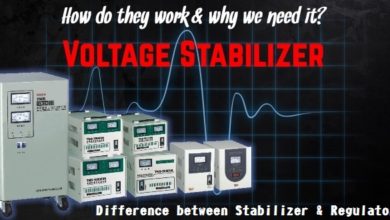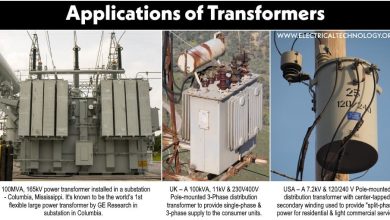Losses in a DC Generator – Power Stages & Efficiency of DC Generator
Losses, Power Stages and Efficiency of a DC Generator
Losses in DC Generator
A generator converts mechanical energy into electrical energy. During the energy conversion in the DC machine, there are different types of losses happens in the DC generator as follows:
- Electrical Losses
- Magnetic Losses
- Mechanical Losses
Let’s discuss further one by one as follows:
Copper Losses (Electrical Losses)
Electrical losses in a DC generator are also known as copper losses which occur due to resistance of the armature windings and the field (series and shunt) windings.
The copper loss can be classified into the following three categories.
Armature Copper Loss (Ia2Ra): Losses occur in the armature winding
Shunt Copper Loss (Ish2Rsh): Losses occur in the shunt field winding
Series Copper Loss (Ise2Rse): Losses occur in the series field winding
This way, the total copper loss in a DC generator:
Total Cu. Loss = Ia2Ra + Ish2Rsh + Ise2Rse
Armature cu. losses are 30-40% while the shunt and series field winding losses are 20-30% of FL losses. Keep in mind that the brush contact resistance loss “PB = VBD Ia where the VBD is the voltage drop at brushes” (due to the surfaces of brush contact with commutator) is also categorized in the armature Cu. losses.
Related Posts:
- Losses in Alternator – Power Stages & Efficiency of Synchronous Generator
- Losses in a DC Motor – Power Stages & Efficiency of DC Motor
Iron Core Losses (Magnetic Losses)
The iron or core losses (also known as magnetic losses) can be categorized as follows:
Hysteresis Losses
When the excited armature rotates in a defined direction, the amount of flux changes again and again due to the changes in the direction of rotation. For this reason, losses occur during the armature operation which is known as hysterias loss.
These losses depend on the maximum value of flux density and the frequency of reversal of magnetism. These losses can be calculated using the following formula.
Hysteresis Losses = WH ∝ BMax1.6 fV
Where:
- WH = Hysteresis Losses
- BMax = Maximum flux density
- f = Frequency
- V = Volume of the core
There is no way to minimize the hysteresis loss except to use a material (such as metal, iron) for the core having low coefficient of hysteresis.
Eddy Current Losses
When a conductor cuts a magnetic field (flux linkage), then EMF is induced according to Faraday’s law of electromagnetic induction. This way, when the armature rotates in the magnetic field, an EMF induced in it but an additional EMF induced in the laminated core.
Although the amount of additional EMF is very small, it drives high current (which is known as eddy current) because of the low resistance of the core as the area of core is comparably large enough.
In other words, the rotational current in the armature core is defined as eddy current. The loss that occurs due to this current is known as eddy current losses which can be determined using the following formula.
Eddy Current Losses = WE ∝ BMax2f2t2V
Where:
- WE = Eddy Current Losses
- BMax = Maximum flux density
- f = Frequency
- t = Width of limitation
- V = Volume of the core
As the above formula shows that the eddy current losses are directly proportional to the square of the width of each lamination, thus it can be minimized to reduce the size of laminated core.
Both hysteresis and eddy current losses are constant in the shunt and compound wound generators as the field current is almost constant in these types of generators. These losses are 20-30% of the total full load losses.
Related Posts:
- Losses in a Induction Motor – Power Stages in Induction Motors
- Losses in Synchronous Motor – Power Stages & Efficiency of Synchronous Motors
Frictional & Windage Losses (Mechanical Losses)
These losses are also known as rotational or mechanical losses in the DC generator which can be categorized as follow:
Brush Friction Losses:
The power loss occurs due to the friction between surfaces of brush and commutator is known to be the brush friction loss.
Bearing Friction Losses:
The loss occurs due to the friction on both bearings connected to the shaft is known to be the bearing friction loss. The losses increase when the grease in the bearing wastes, deteriorates or dries out.
Windage Losses:
The power losses occur due to the friction between rotating armature and air is known as windage loss or air friction loss. This is because the armature needs to be pushed against the wind to rotate.
Hence, total losses of the DC generator can be defined as follow:
Total Losses = Variable Losses + Constant Losses
Where:
- Constant Losses = Iron & friction losses and shunt field losses in shunt and compound DC generators.
- Variable Losses = I2R losses in the armature, series winding and interpole windings.
Good to know: Frictional losses + magnetic losses e.g. (mechanical losses + magnetic losses) are known as stray losses.
Related Posts:
- Losses in Electrical Machines – Formulas and Equations
- Transformer Losses – Different Types of Losses in a Transformer
Power Stages in DC Generator
When a DC generator converts input mechanical power into output electrical power, there are some losses during energy conversion. For this reason, the output of the generator is always less than the input. All the generator’s losses during the energy conversion in the machine at different stages is known as power stages of the DC generator as shown in fig below.
The losses and efficiencies can be determined using the following formulas and equations.
A – B = Iron and friction losses
B – C = Copper losses
Mechanical Efficiency = ηM = B / A = EIa / (B.H.P × 746)
Electrical Efficiency = ηE = C / B = VI / EIa
Overall (Commercial) Efficiency = ηC = C / A = VI / (B.H.P × 746)
Efficiency of DC Generator
The efficiency of a machine is defined as a ratio of output and input. It is denoted by the symbol of “η” and expressed in percentage “%”.
Efficiency = η = (Output / Input) × 100
There are some losses in each machine, this way; the output is always less than the input. e.g.
Output = Input – Losses
Input = Output + Losses
Therefore, the efficiency can also be determined as follows:
Efficiency = η = (Output / (Output + Losses)) × 100
Efficiency = η = (Input – Losses) / Input)) × 100
Related Post:
- What is Motor Efficiency and How to improve it?
- Transformer Efficiency, All day Efficiency & Condition for Maximum Efficiency
Condition for Maximum Efficiency
The efficiency of a DC generator will be maximum when the constant and variable losses become equal. Mathematically
- Generator output = VI
- Generator Input = Output + Losses
Putting the values of output and losses
= VI + Ia2Ra + WC … (Where Wc is constant losses)
= VI + (I + ISh)2 Ra + Wc … (Ia = I + ISh)
The value of shunt current (ISh) is too small as compared to the load current (I), thus, it can be neglected.
Efficiency = η = Output ÷ Input
= VI ÷ (VI + Ia2 Ra + Wc)
= VI ÷ (VI + I2 Ra + Wc) … (∴ Ia = I)
Multiplying the above equation (all values) and dividing by VI:
η = (VI ÷ VI) ÷ ((VI ÷ VI) + (I2 Ra ÷ VI) + (Wc ÷ VI))))
η = 1 ÷ ((1) + (IRa ÷ V) + (Wc ÷ VI))))
It shows the efficiency will be maximum when the denominator is minimum. That’s mean
d/dI (IRa ÷ V) + (Wc ÷ VI) = 0
Differentiating the above equation w.r.t “I”.
= (Ra ÷ V) – (Wc ÷ VI2) = 0
= (Ra ÷ V) = (Wc ÷ VI2) = 0
I2RaV = WcV
I2Ra = Wc
The above calculations prove that the efficiency will be maximum once the variable and constant losses of the generator become equal to each other.
Variable Losses = Constant Losses
The load current at maximum efficiency can be calculated using the following formula.
I = √(Wc ÷ Ra) … or
I2 Ra = Wc
Related Posts:
- Single-Phase Induction Motor – Construction, Working, Types & Applications
- Three-Phase Induction Motor – Construction, Working, Types & Applications
- Alternator or Synchronous Generator: Construction, Working, Types & Applications
- Synchronous Motor: Construction, Working, Types & Applications
- Synchronous, Stepper and AC Motors Formulas and Equations
- EMF Equation of an Alternator and Synchronous Generator
- EMF Equation of a Transformer
- Power, Voltage and EMF Equation of a DC Motor
- Torque Equation of Induction Motor
- Equivalent Circuit of Induction Motor
- Equivalent Circuit of Electrical Transformer
- Difference between Synchronous and Asynchronous Motor








